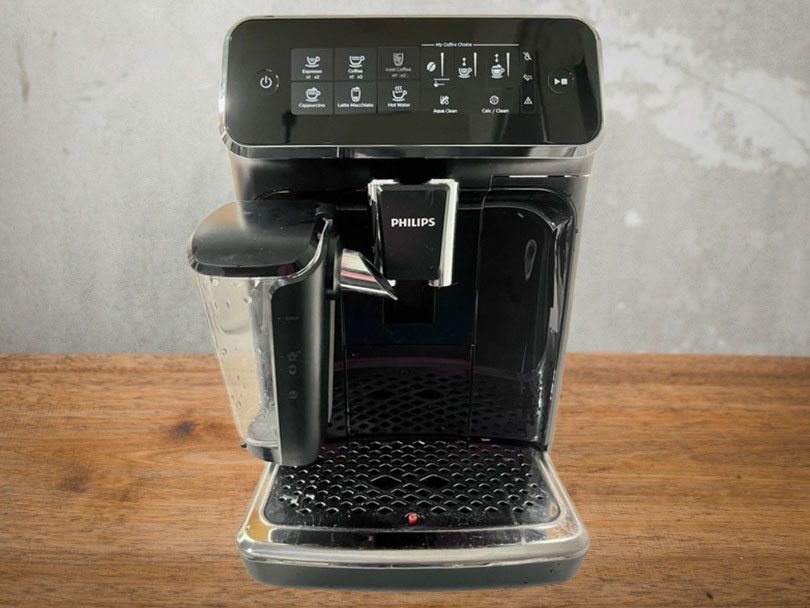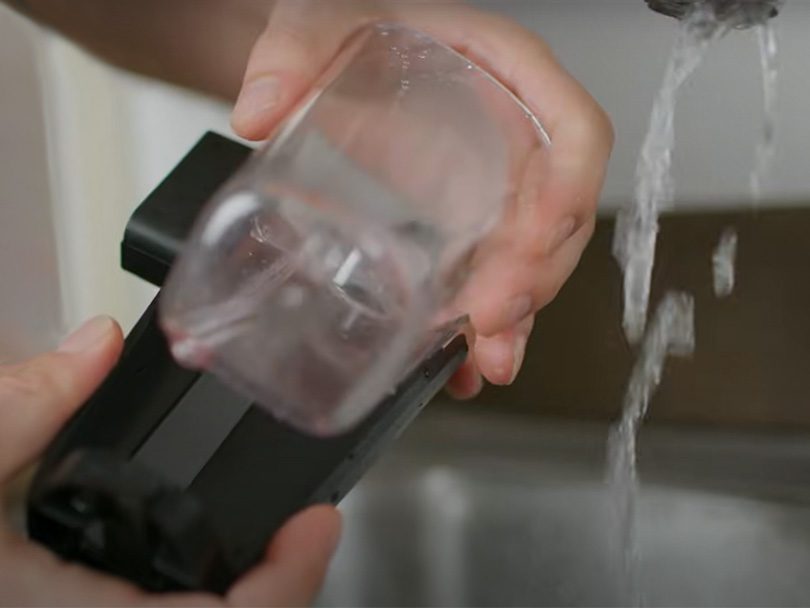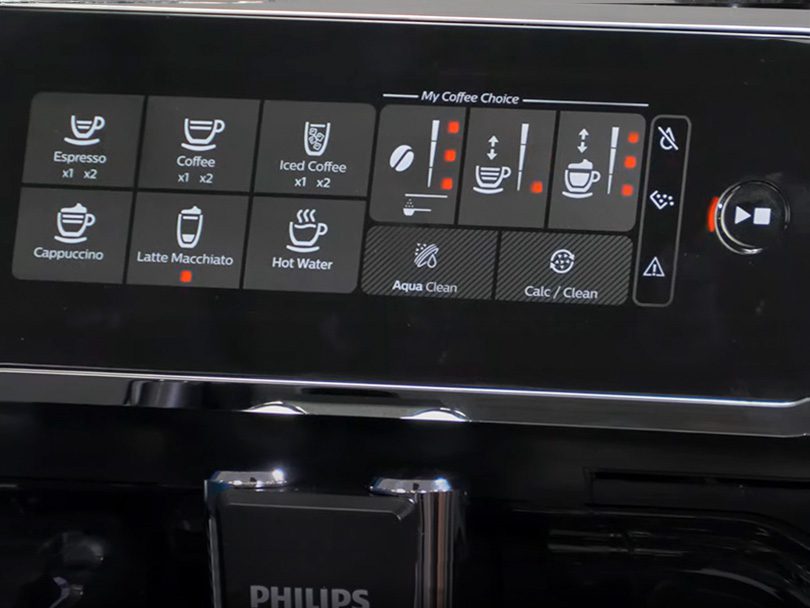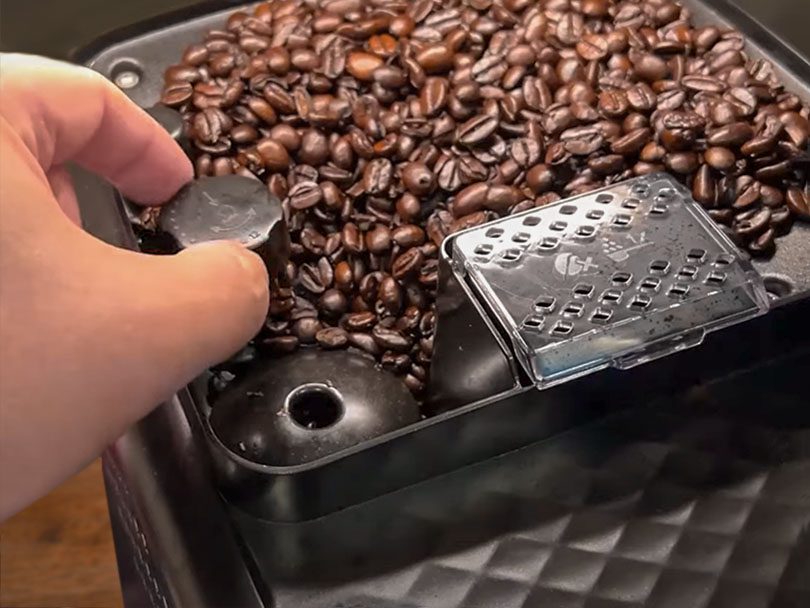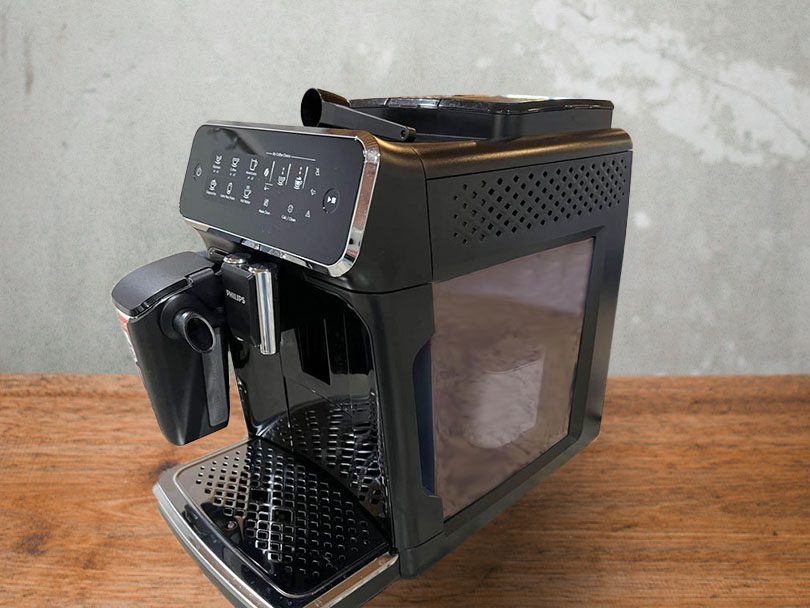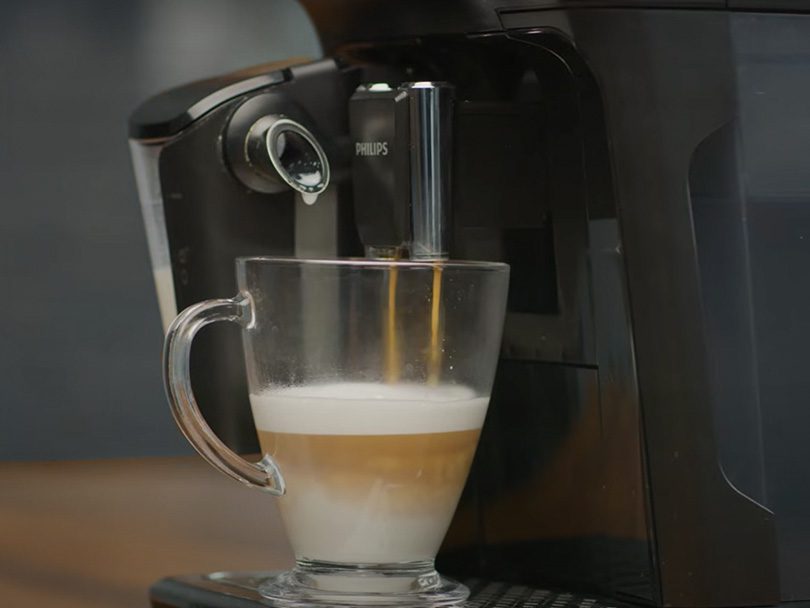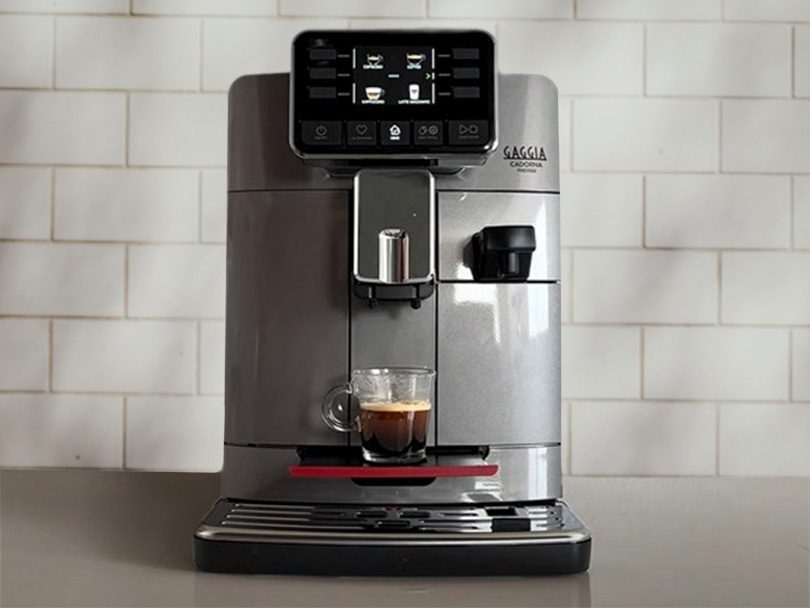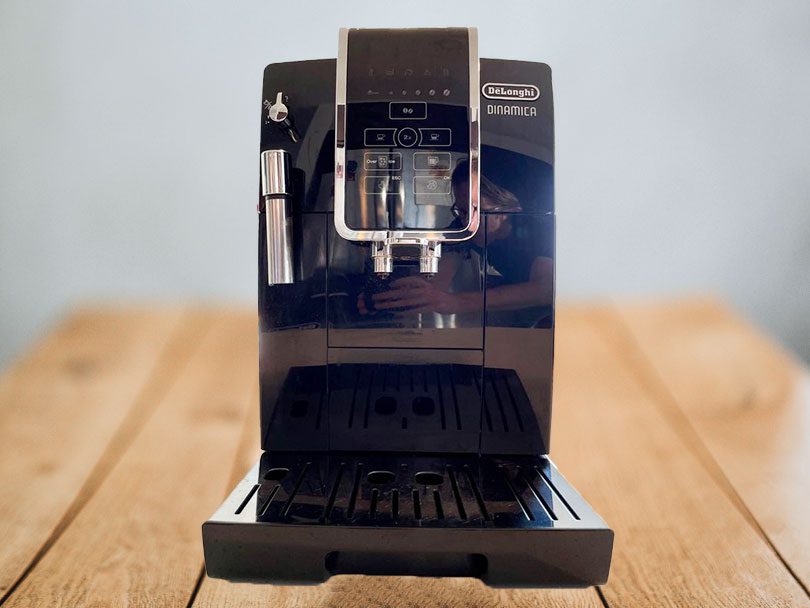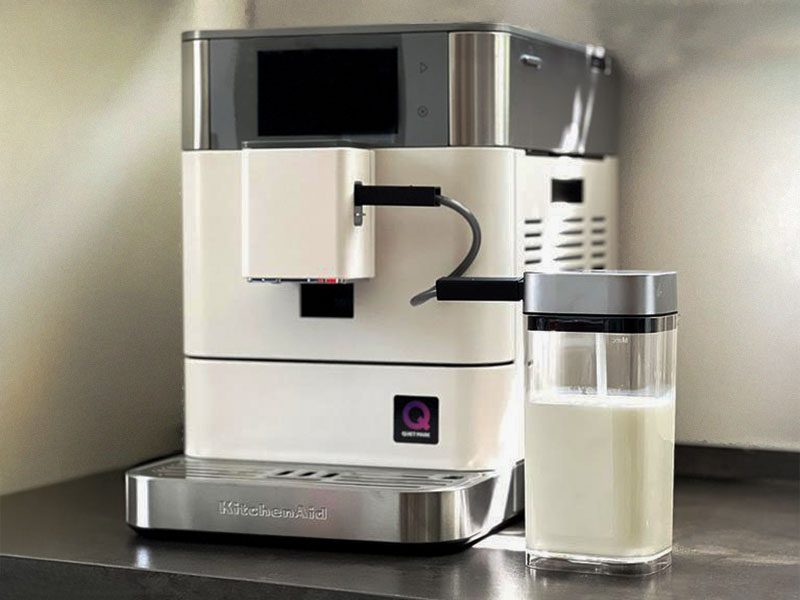If you’re shopping for a super-automatic espresso machine on a budget, Philips should be at the top of your wish list. (They also own Saeco for the higher-end crowd.) For milky coffee lovers, their “LatteGo” series offers very good value and is loved for being simple to use and clean. So it was about time we bought and tested one to share our unbiased thoughts in this Philips 3200 LatteGo review.
For the TL;DR version, the Philips 3200 is impressively simple to use and clean. There aren’t a lot of settings to play with or coffees to choose from. But that’s the point. Choose your coffee, adjust the 3 settings, and you’re done. While not as impressive as the Gaggia Cadorna Prestige, it is perfect for those who value coffee being easy.
There are good and bad points to keeping things so simple. After using the Philips 3200 we’ve worked out what they are so you can decide if it’s your ideal coffee buddy.
This article may contain affiliate/ compensated links. As an Amazon Associate, we earn from qualifying purchases at no additional cost to you. For more information please see our disclaimer here.
The Philips 3200 LatteGo succeeds in being great value and extremely easy to use. Programming your drinks is foolproof and the resulting coffee is pretty good.
It’s not the prettiest or the best quality option out there, for a little bit more money you can get the Gaggia Cadorna Prestige, which we think is significantly better (see our review for why).
But it depends on what you want. The iced coffee feature works really well, and a dishwasher-safe milk container is a rare and beautiful thing.
Overall, if you want things to be easy and you love iced coffee, the 3200 LatteGo is a brilliant espresso machine. But, for everyone else, we think you’ll be better off with the Cadorna Prestige.
Pros
- Brews good espresso and coffee
- Simple interface
- Flat burr ceramic grinder
- Iced coffee option (latest model only)
- Very easy to clean
- Great value
Cons
- Milk foam is a little too dense
- Loud
1. Ceramic Flat Burr Grinder
Without starting fights over stainless steel vs ceramic and flat vs conical burrs, a ceramic flat burr grinder at this price is pretty impressive. You generally only see them on much much more expensive machines.
The grinder has 12 grind settings and is very fast.
The ceramic material helps prevent the beans from heating up whilst being ground, preserving the volatile oils that help produce flavor. For me, the only downside is that it’s loud.
2. Iced Coffee Function
Are you an iced coffee fan on those hot summer days? The new version of the Philips 3200 LatteGo offers “Iced Coffee” as one of its drink options, available at the push of a button.
The coffee is brewed at around 165°F (74°C), a drop of roughly 35°F from normal, and the flow rate is slowed right down to ensure even extraction.
The result is a more concentrated coffee that you can brew over ice. To make an iced americano, you can dilute this with water, or add milk/creamer for other iced coffee drinks.
As this is a new feature, many retailers are still selling off old stock so check whether it has the iced coffee feature before you buy. With the iced coffee feature, the model number is EP3241/74; without it, the model number is EP3241/54 – an easy difference to miss.
3. Easy Clean Milk System
The worst part of cleaning any coffee machine is the milk system. Whether that’s scrubbing a steam wand or trying to deep clean tubes. However, the LatteGo system on the Philips machines has no inner tubes and comes apart into 2 pieces which can be easily cleaned in the sink. It’s also dishwasher safe.
4. Intuitive Touch Buttons
It’s not a touchscreen but the buttons are touch-activated. Compared to some espresso machines that have overly (or underly?) sensitive touchscreens, I’m a big fan of how easy the 3200 makes it to use.
All the options you need are nicely laid out with LED lights to indicate your selection. Once you’ve picked your preferred options, all you need to do is push the start button – the one with the “play/pause” symbol.
Everything is available via the touch buttons on the simple user interface. There are 5 drinks to choose from (espresso, coffee, iced coffee, latte macchiato, and cappuccino) plus options for strength, coffee size, and milk size. These all light up to show you which of the 3 settings is selected.
I like how simple it is – anyone can work it out and there’s no need to enter any special settings menus to adjust things. Even my 90-year-old Grandad managed it.
You start by picking your preferred drink, for example, the latte macchiato. Then you can adjust each of the settings in turn. I like to turn the strength up to 3, the coffee volume to 1, and the milk volume to 3 but you might prefer something different. Once you’re set, press the start button, and off it goes.
With only 3 options for strength and coffee/milk volume, it’s fairly limited compared to more expensive machines. However, it’s also possible to adjust the brewing temperature when the machine is off by holding the “coffee size” button. This will start flashing and you can choose between 3 levels (we recommend the highest setting).
Some other super-automatic machines in the same price range have more customization options. But none of them are this simple to use.
With a max dose of 11g, it’s a little long for our tastes. But it’s not bad since many machines won’t do better than a 1:3 ratio outside of the more expensive Jura espresso machines.
The smallest espresso the 3200 LatteGo can make is just over 1oz. However, this is only possible by selecting a “small cappuccino”. On the espresso setting, the smallest size is 1.25oz. Make it make sense!
Using the Iced Coffee Function
When brewing an iced coffee you should brew directly onto ice cubes. Or steal our insider tips and make frozen coffee cubes or use these gamechangers.
The coffee is brewed at a lower temperature and the flow rate through the puck is slowed considerably to ensure full extraction and avoid sour coffee. But it’s not properly cold coming out so it tastes a bit weird without the ice.
It’s designed to be like an espresso style that needs to be diluted with water or milk, though the longer settings are okay as they are. We made an iced americano which I thought was a little bitter but still pretty good.
When mixed with milk or creamer you get a pretty impressive drink. The slight sweetness takes away the bitter edge and we enjoyed a nicely balanced iced latte.
This is a really good feature on a budget machine.
An espresso can only be as good as the beans you use to make it. So we recommend sticking with fresh whole beans for the best results. (If you’re looking for inspiration, we asked a bunch of coffee experts for their favorites.) The hopper can hold 10oz of beans.
One way to divide a room of coffee experts is to start a debate over stainless steel vs ceramic grinders, and flat vs conical burrs. But the long and short of it is that the ceramic flat burr grinder on the Philips 3200 LatteGo is an incredible feature that feels like it belongs on a significantly more expensive machine.
When adjusting the grinder (there are 12 settings), Philips recommends adjusting one step at a time while the grinder is running. This stops the grinder from being damaged by trying to crush any beans that are between the burrs. It also ensures you get a uniform grind size for your espresso.
Grinders are precious and ceramic grinders can chip so wasting some coffee beans to keep it in good shape is definitely worth it.
Our only complaint is that the grinder is quite loud. If you’re sharing an apartment or need to make coffee while others are sleeping, you might find yourself in trouble.
Of the 12 grind settings, we found 6 of them were actually useful. The coarsest 6 produced coffee that was too weak or sour (this is a fairly common issue with super-automatic grinders). That said, if you’re using super dark roast beans then the coarser settings may work for you.
The Looks
It looks a little like a vending machine with all the buttons nicely labeled. So it’s maybe not at the cutting edge of coffee machine design, but it would be harsh to call it “ugly”.
At this price, we expect nothing but plastic exteriors so the chrome accents are a nice touch and overall we can’t fault the look (too much!).
For this type of espresso machine, the Philips 3200 also has a reasonably small footprint. It’s 15 inches wide and only 10 inches deep. Which may still cause you an issue trying to fit all your appliances next to each other. Although, it does give you space in front of the machine so maybe I’m being too harsh.
It’s also fairly tall – 17 inches. You need to be able to access the bean hopper from the top so consider any well-mounted cabinets when you plan where to put your new Philips espresso machine.
The Build
For a super-automatic, the Philips 3200 LatteGo is a budget espresso machine. But it’s still a significant investment in your coffee future. One that will save you money throughout its life if you’re replacing the daily cafe run.
Philips promises 20,000 cycles from its grinder. So if you’re making 4 coffees per day, you’re looking at over 13 years before the grinder gives out.
It’s unlikely the whole machine will work for that long, but we’ve seen people posting 15-year-old super automatics on Reddit that still work so maybe it will. But the point is, this machine has been built to last. Since $800 is only 200 lattes from a chain coffee store, it could save you money within a year.
Nothing feels cheap either. The milk container is sturdy, easy to clean, and has no small parts that might fail. You can easily remove the brew group for cleaning too. So, as long as you keep on top of maintenance, I’d expect the 3200 to be fine for 5 years or more.
For peace of mind, Philips includes a 2-year warranty.
Straight out of the box, the espresso wasn’t the greatest. However, once we’d run through 6 shots, we started to see a big improvement as it took some time to settle and calibrate.
I’d prefer to be able to get a 1:2 ratio of coffee grounds in to espresso out. But if you turn the temperature to the highest setting, set the grinder at 2 or 3, use the max dose, and 1.25oz output, you’ll get a full-bodied and syrupy espresso.
Don’t get me wrong, it’s not going to be a life-changing espresso. It will be a good one and that’s all we can ask for from a machine at this price.
The latte macchiatos are very good too:
It dispenses the milk first then espresso so you get those perfect layers and a nice level of textured milk foam. Weirdly it brews cappuccino the same way – milk first then coffee – so it ends up like a strong version of a latte macchiato.
I’ve seen some people have issues with getting any milk foam from the Philips 3200 LatteGo but, if anything, we felt the foam was a little too dense. I can only assume they were using the wrong milk or it was too warm in the container. So, issues aside, you’ll enjoy this machine if you like dense milk foam.
Iced coffee brewing is becoming much more common in automatic coffee makers (the DeLonghi range is leading the charge here). This coincides with the supposed 4th wave coffee movement where iced coffee sales are booming so manufacturers of home machines are giving the people what they want.
The 3200 executes this feature pretty well too. The brewing temperature is lower and the flow rate is slowed down to allow for full extraction at the lower temperature.
But it’s not really a ready-to-drink iced coffee. Instead, it’s more of a coffee concentrate that’s designed to be brewed over ice and then diluted with water, creamer, or whatever takes your fancy.
Keeping the milk system on any espresso machine is annoying and by far the most critical part of machine maintenance. Milk goes nasty very quickly and is a nightmare to clean once it does. This is why the easy-to-clean, dishwasher-safe milk system is one of my favorite things about the Philips LatteGo system. I’m painfully aware of how “mid-30s” that is to say.
You have to do the usual tasks like emptying the pucks bin and drip tray, and then rinsing those out. It also helps to vacuum out your grinder every week or so.
Then there’s the descaling:
The instruction manual is very firm on only ever using Philips descaling products and under no circumstances use vinegar. So you should do what they say (especially when under warranty!)
It takes 30 mins total to descale the 3200 LatteGo though it’s not complicated. With an empty drip tray and puck container, you need to empty the water reservoir and remove the water filter, then refill the reservoir, and add a whole bottle of descaler. Then press and hold the “Calc/Clean” icon for 3 seconds and push start.
Just make sure you have a large container under the coffee and hot water spouts.
How frequently you need to descale depends on how much you use your machine and how hard your water is. It could be anything from monthly to every 3 months. It’s not difficult though and is universal across all super-automatic espresso machines.
Gaggia Cadorna Prestige
Espresso Quality: 8.5/10
Milk Quality: 9/10
Drinks Options: 9/10
Value for Money: 10/10
Overall Rating: 9/10
Or read our Complete Gaggia Cadorna Prestige Review
Our favorite budget automatic espresso machine, the Gaggia Cadorna Prestige is seriously impressive. It has 12 coffee options, 4 user profiles to save drinks, a superb ceramic grinder, and an excellent milk system.
The manufacturers’ list prices put the Cadorna Prestige as more expensive than the 3200 LatteGo. But, they’re both often found on sale so they might be closer in price when you’re shopping around.
If you’re looking for great coffee quality and more options from a budget-friendly machine then the Cadorna Prestige is the obvious choice. The user profiles make it better for a house with a few coffee drinkers too.
It’s also better looking if that’s a big factor for you.
The downside is that it doesn’t have an Iced Coffee option. So if that’s a big draw for you then you’re better off with the Philips. For everyone else, we’d choose the Gaggia.
DeLonghi Dinamica
The Dinamica is a little bit of an odd duck.
It has a manual panarello-style milk wand and 4 coffee recipes. So in theory you can make whatever coffee you like, with the wand giving you a helping help for latte or cappuccino.
But this requires frothing your own milk, which isn’t hard but might be more effort than you really want. As it’s pretty much the same price as the Philips and the Gaggia, we don’t think it’s the best option.
It’s a strong sales pitch: decent espresso and a nice latte macchiato or cappuccino for a great price and with zero difficulty in using or cleaning.
We really like this Philips espresso machine. Anyone that’s replacing a single-serve machine will be very happy with the results and the lack of settings to muddle through.
It’s just not perfect. So we’d rather get the Gaggia Cadorna Prestige as it’s the better espresso machine with more options for pretty much the same price. It looks better too.
The Philips 3200 LatteGo is good, it’s just the Gaggia is better in our opinion.
Don’t forget to buy your Philips 3200 LatteGo
You Might Also Like
-
DeLonghi Magnifica Start Review
Looking for an affordable, easy-to-use espresso machine? Check out our DeLonghi Magnifica Start review to see how it stacks up and performs
-
KitchenAid KF8 Review
The KF8 is the flagship espresso machine from KitchenAid, but is it the best? We did an in-depth KitchenAid KF8 review to find out

